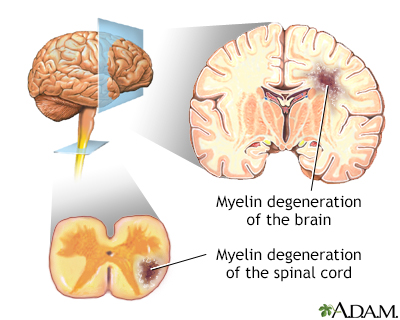CSF oligoclonal banding
Cerebrospinal fluid - immunofixationCSF oligoclonal banding is a test to look for inflammation-related proteins in the cerebrospinal fluid (CSF). CSF is the clear fluid that flows in the space around the spinal cord and brain.
Oligoclonal bands are proteins called immunoglobulins. The presence of these proteins indicates inflammation of the central nervous system. The presence of oligoclonal bands may point to a diagnosis of multiple sclerosis.
How the Test is Performed
A sample of CSF is needed. A lumbar puncture (spinal tap) is the most common way to collect this sample.
Lumbar puncture
Cerebrospinal fluid (CSF) collection is a test to look at the fluid that surrounds the brain and spinal cord. CSF acts as a cushion, protecting the b...

Other methods for collecting CSF are rarely used, but may be recommended in some cases. They include:
- Cisternal puncture
- Ventricular puncture
- Removal of CSF from a tube that is already in the CSF, such as a shunt or ventricular drain.
After the sample is taken, it is sent to a lab for testing.
Why the Test is Performed
This test helps support the diagnosis of multiple sclerosis (MS). However, it does not confirm the diagnosis. Oligoclonal bands in the CSF may also be seen in other illnesses such as:
Multiple sclerosis
Multiple sclerosis (MS) is an autoimmune disease that affects the brain and spinal cord (central nervous system).

- Systemic lupus erythematosus
- Human immunodeficiency virus (HIV) infection
- Stroke
Normal Results
Normally, one or no bands should be found in the CSF.
Note: Normal value ranges may vary slightly among different laboratories. Talk to your health care provider about the meaning of your specific test results.
The examples above show the common measurements for results for these tests. Some laboratories use different measurements or may test different specimens.
What Abnormal Results Mean
There are two or more bandings found in the CSF and not in the blood. This may be a sign of multiple sclerosis or other diseases causing inflammation in the central nervous system.
References
Deluca GC, Griggs RC. Approach to the patient with neurologic disease. In: Goldman L, Schafer AI, eds. Goldman-Cecil Medicine. 26th ed. Philadelphia, PA: Elsevier; 2020:chap 368.
Karcher DS, McPherson RA. Cerebrospinal, synovial, serous body fluids, and alternative specimens. In: McPherson RA, Pincus MR, eds. Henry's Clinical Diagnosis and Management by Laboratory Methods. 24th ed. Philadelphia, PA: Elsevier; 2022:chap 30.
CSF oligoclonal banding - series
Presentation
Lumbar puncture (spinal tap) - illustration
A lumbar puncture, or spinal tap, is a procedure to collect cerebrospinal fluid to check for the presence of disease or injury. A spinal needle is inserted, usually between the third and fourth lumbar vertebrae in the lower spine. Once the needle is properly positioned in the subarachnoid space (the space between the spinal cord and its covering, the meninges), pressures can be measured and fluid can be collected for testing.
Lumbar puncture (spinal tap)
illustration
CSF oligoclonal banding - series
Presentation
Lumbar puncture (spinal tap) - illustration
A lumbar puncture, or spinal tap, is a procedure to collect cerebrospinal fluid to check for the presence of disease or injury. A spinal needle is inserted, usually between the third and fourth lumbar vertebrae in the lower spine. Once the needle is properly positioned in the subarachnoid space (the space between the spinal cord and its covering, the meninges), pressures can be measured and fluid can be collected for testing.
Lumbar puncture (spinal tap)
illustration
Review Date: 4/29/2023
Reviewed By: Joseph V. Campellone, MD, Department of Neurology, Cooper Medical School of Rowan University, Camden, NJ. Review provided by VeriMed Healthcare Network. Also reviewed by David C. Dugdale, MD, Medical Director, Brenda Conaway, Editorial Director, and the A.D.A.M. Editorial team.








